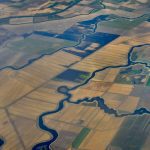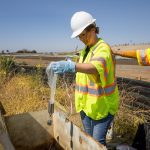- Reaching dead pool means Lake Mead would be too low to release water downstream.
- Hydroelectric power would cease if water falls below outlet elevation near 895 ft.
- Farmers, cities, tribal communities, and Mexico would face severe reductions.
- Infrastructure like Nevada’s mid‑lake intake offers partial resilience.
- Federal water shortage tiers would deepen, affecting allocations to Arizona and Nevada.
Friday, August 22, 2025 –– Lake Mead reaching “dead pool”—the point at which water can no longer flow through the dam’s outlets—would mark a critical turning point. Lake Mead, the country’s largest reservoir, sits behind the Hoover Dam on the Colorado River, spanning the border of Nevada and Arizona. Once a symbol of abundance in the Southwest, it now faces an uncertain future. Federal forecasts show the reservoir could hit a record low by 2027, even though levels have temporarily steadied. Years of shrinking Colorado River flows , combined with growing demand from cities and farms, are draining its reserves. As the waterline retreats, it is not only straining supplies for drinking and irrigation, but also revealing long-submerged landscapes. The decline of Lake Mead is more than a regional issue—it’s a warning signal for millions who depend on the Colorado River.
, combined with growing demand from cities and farms, are draining its reserves. As the waterline retreats, it is not only straining supplies for drinking and irrigation, but also revealing long-submerged landscapes. The decline of Lake Mead is more than a regional issue—it’s a warning signal for millions who depend on the Colorado River.
If it even happens at all, this scenario would not occur within two years based on current federal projections . According to the U.S. Bureau of Reclamation’s August 2025 two-year study, Lake Mead’s elevation is expected to remain between 1,050 and 1,075 feet as of January 1, 2026, well above the dead pool level at 895 feet.
. According to the U.S. Bureau of Reclamation’s August 2025 two-year study, Lake Mead’s elevation is expected to remain between 1,050 and 1,075 feet as of January 1, 2026, well above the dead pool level at 895 feet.
Understanding Dead Pool and Its Consequences.
“Dead pool” refers to reservoir levels so low that water cannot flow downstream of the dam by gravity. At Lake Mead, this occurs when levels fall below approximately 895 feet .
.
Hydropower production would also cease when water levels drop below the dam’s intake capacity. Hoover Dam’s turbines require a minimum level near 950 feet to operate, even though retrofits in 2015–2016 lowered the generation threshold.
lowered the generation threshold.
Who Would Be Affected?
-
Lower Basin States (California, Arizona, Nevada): Water deliveries would halt entirely. These states
 rely heavily on releases from Lake Mead for urban supply and agriculture.
rely heavily on releases from Lake Mead for urban supply and agriculture. -
Agriculture: Vast areas of farmland—including California’s Imperial Valley—would lose critical irrigation water
 .
. -
Power Supply: Hoover Dam currently provides electricity to about 1.3 million people
 . Dead pool would cut power generation, causing widespread energy disruptions.
. Dead pool would cut power generation, causing widespread energy disruptions. -
Tribal and Mexican Communities: Tribes within the basin and Mexico
 (which receives a legal share) would face sharp supply cuts or complete loss of river water.
(which receives a legal share) would face sharp supply cuts or complete loss of river water.
Partial Mitigations Already in Place.
-
Nevada’s Mid‑Lake Intake (“Third Straw
 ”): Completed in 2014, this tunnel at 860 feet allows Nevada to continue drawing water even below dead pool levels.
”): Completed in 2014, this tunnel at 860 feet allows Nevada to continue drawing water even below dead pool levels. -
Tiered Shortage Levels:
-
Light Shortage (below 1,075 ft but above 1,050 ft): California, Arizona, Nevada receive reduced but still significant allocations.
-
Heavy Shortage (below 1,050 ft but above 1,025 ft): Smaller allocations across the board.
-
Extreme Shortage (below 1,025 ft): Further reductions aligned with legal formulas.
-
Under current most probable projections, Lake Mead could fall below 1,050 feet by July 2026, triggering a heavy shortage. A worst-case scenario forecasts levels near 1,026 feet by mid‑2027—still above dead pool but serious.
levels near 1,026 feet by mid‑2027—still above dead pool but serious.
It’s All Theoretical.
Dead pool would bring cascading consequences—dry taps, darkened turbines, parched fields, and stalled hydropower. Current modeling does not predict reaching that point within two years, though the trajectory remains concerning.




Thanks for your comment, Rosalie. Arizona and California have been looking at desalination quite a bit, but I don’t know that they were thinking of using it to fill Lake Mead. It might be cost-prohibitive to pipe desalinated water to the lake, but it’s certainly an interesting idea. https://www.western-water.com/?s=desalination Some of these ideas involving desalination and some other options, such as getting rid of Glen Canyon Dam, are discussed by this columnist: https://www.postregister.com/opinion/guest_column/other-options-being-evaluated-to-solve-southwest-us-freshwater-issues/article_dd05f01c-0ab6-5d88-be3b-29f69c17e3e0.html